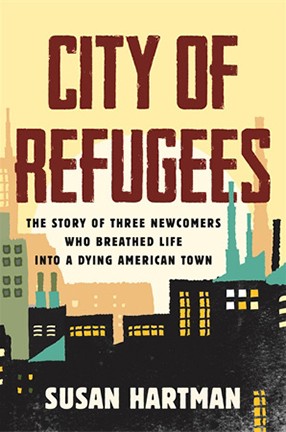Here’s How Refugees Are Reshaping America
Professor Susan Hartman portrays the lives of newcomers to this country in her recently published book.

Many Americans imagine refugees as threatening outsiders who will steal jobs or be a drain on the economy. But across the country, refugees are rebuilding and maintaining the American Dream. In City of Refugees: The Story of Three Newcomers Who Breathed Life into a Dying American Town, journalist Susan Hartman (SOA’76), an adjunct professor of writing at the School of the Arts, shows how an influx of refugees helped revive Utica, New York, an old upstate manufacturing town that was nearly destroyed by depopulation and arson.
Hartman follows three of these newcomers over the course of eight years, as they and their families adjust to new lives in America. There's Sadia, a Somali Bantu teenager who rebels against her formidable mother; Ali, an Iraqi translator who creates a home with a divorced American woman, but is still traumatized by war; and Mersiha, a Bosnian who wants to open a café.
Hartman talks about the book with Columbia News, along with what she’s read recently and what’s next on her reading list, what she’s learned from Elena Ferrante, and the course she’s teaching this fall.
What inspired you to write this book?
In 2013, I got a call from a stranger, a Hamilton College economics professor, who knew I often wrote about immigrant communities. He said, “Did you know Utica, New York, has become a city of refugees?”
He offered to show me around. I’d gone to school near Utica in the 1970s—and had an affection for the old industrial town. A few days later, I was in the professor’s car: I saw a city that had been transformed by refugees.

Of all the refugees who have settled in Utica, how did you decide to focus on Sadia, Ali, and Mersiha, and what was it like to follow them for eight years?
These three newcomers were going through so many changes: Sadia, a bright Somali Bantu girl was butting heads with her mother; Ali, an Iraqi interpreter, was torn between his life here and his family in Iraq; and Mersiha, an ebullient Bosnian woman, was dreaming of opening a café. I kept wanting to see what was next.
It wasn’t always easy to connect, especially with Sadia. Like many teenagers, she’d lose her cell phone. And for a while, I lost touch with Ali when he returned to Iraq. But following these three people was a joy.
What have you read recently that you would recommend, and why?
I just finished Valentino and Sagittarius, two novellas by Natalia Ginzburg. She was a master at capturing the dynamics of family life—and her observations are sharp, fresh, and often humorous.
What's next on your reading list?
I love the stories of Alice Munro. There’s something journalistic in her attention to detail, and her ability to evoke a place. I’m looking forward to catching up with her early work: Lives of Girls and Women and Something I’ve Been Meaning to Tell You.
How have your reading tastes changed over time?
I started out as a poet, and read poetry and fiction all through my twenties. Since becoming a journalist, I’ve read mostly newspaper articles and nonfiction. Now I’m hungry to read fiction!
What is the most interesting thing you learned from a book recently?
I read The Lying Life of Adults by Elena Ferrante, and admired how she sometimes pulls back and comments on her characters. Journalists are trained to show, rather than explain. But after reading Ferrante’s novel, I felt freer—in the right context—to give the reader a bit of guidance.
What are you teaching this fall?
I’m teaching Writing About Communities; it’s my favorite course. Students choose an intimate community outside of campus—it could be a group of domino players or regulars at a butcher shop—and then they write a feature story.
You're hosting a dinner party. Which three academics and/or writers would you invite, and why?
Michael Winerip and N.R. Kleinfield, veteran reporters who’ve written about ordinary people with empathy and a sharp eye. I’d also invite Jen Percy, another writer, because of the lyrical quality of her stories. I’d love to hear what they have to say about the writing process.